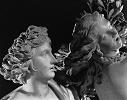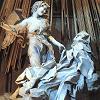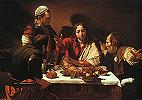The Baroque Style* in Sculpture and Painting |
The Baroque Style* in Sculpture and Painting |
While the term "baroque" is often only a time designation, we will now use it to define a style in both painting and sculpture. The characteristics of the baroque style are the following:
As you look at the works below, test these definitions.
|
Bernini Pluto and Persephone 1621-
|
|

|
Bernini, whose works we will see often on this Baroque site, depicts a subject from classical mythology: the abduction of Persephone by Pluto, the god of the underworld. Bernini shows the climactic moment in a very dramatic way. The work is very realistic -- seen especially in Bernini's interest in textures not usually depicted so naturalistically in sculpture. Here even evanescent tears are rendered in stone.
|
|
Bernini Apollo and Daphne 1622-25 |
|
  |
Another early work by Bernini, this sculpture also depicts a seduction, derived from classical mythology as told by Ovid. (Bernini, an extremely religious artist, would go on to depict religious subjects in his later career.) In this story, Daphne is saved from the rape by the gods, who turn her into a laurel tree. Although this metamorphosis is not an easy subject to convey realistically, Bernini does it! Here, at the climactic moment, we see her legs changing to tree trunks and her hands to leaves. Imagine how difficult it is to depict leaves in marble. |
|
Bernini David 1623 |
|
 |
Bernini's depiction of the biblical hero is much more dynamic than Michelangelo's. He depicts the climactic moment, just as David is about the swing. David's feet are spaced widely apart and he stares ahead at Goliath, who is in the viewer's space outside the zone of the sculpture. This illustrates another baroque characteristic: sculpture often invades viewer's space.
|
|
Bernini St. Teresa Altar with The Ecstasy of St. Teresa 1645-52 |
|
  |
Some baroque works are difficult to characterize by media -- are they sculpture or architecture or both? (Also see Bernini's Baldacchino.) Another quality sometimes evident in baroque art, then, is the unification of architecture and sculpture. This whole chapel, off of the nave of the small church, was designed as a sculptural tableau, a whole pictorial scene. When the viewers stand in the chapel they are drawn into the work -- that is, spatial boundaries are eliminated. To their right and left, viewers look into something like opera boxes. There they see relief sculptures of members of the Coronaro family, which had commissioned the work. But those sculptured figures are watching the miracle of St. Teresa's mystical experience of love, and that draws viewers in the chapel back to are witness the miracle as well.
Here, again, we see a very dramatic and emotional work. Baroque artists love eloquent drapery -- it's voluminous and hangs limply to show the saint's exhaustion and surrender to divine love. Another baroque quality is the hidden light source, which also helps to convey the sense of revelation. [Click here to read more about St. Teresa and own account of her experience.] |
Painting |
|
|
Caravaggio Supper at Emmaus c. 1600 |
|
 |
Caravaggio, though short-lived, was one of the most influential baroque painters. Painters throughout Europe copied his theatrical lighting effects, in particular. Like baroque sculptors, Caravaggio here has selected the most climactic moment in the story -- when the disciples recognize the risen Christ. Contrast their violent and intense physical reaction with the clueless innkeeper. And just as Bernini's David seemed to invade the viewer's space, here too the foreshortened arms seem to break through the picture plane and invade our space. Although this is a miraculous moment, Caravaggio has depicted it in believable terms. The figures are not idealized but are real wrinkled men.
|
|
Artemesia Gentileschi Judith and her Maidservant with the Head of Holofernes 1612-21 |
|
 |
Gentileschi, a very well-known painter in her own day, has been rediscovered by twentieth century feminist scholars. Because her father was a painter, she had opportunities denied to most talented women who could not participate in the apprentice system--the method of training artists. She was one of the many imitators of Caravaggio's style, with one difference. She typically chose stories which featured strong, heroic women. What baroque characteristics can you identify in this painting? |
|
Rubens The Rape of the Daughters of Leucippus 1618 |
|
 |
Rubens, a Flemish painter, is as important as Bernini in disseminating the Baroque style. He was an international artist who painted a wide variety of paintings for patrons in many European countries. A prolific artist, he depicted religious and mythical subjects, painted portraits, devised political allegories, and even did landscapes.
Here he depicts a mythical subject -- one of those recurring works of art in which a man victimizes a woman. The subject is inherently dramatic and the unstable composition accentuates its drama, as elements revolve around an axis like a pinwheel. Rubens' color is often dramatic and he is interested in realistic textures -- horses' manes and coats, women's flesh, and the like.
|
|
Rubens Descent from the Cross 1612-14 |
|
 |
Rubens lived in a Catholic country so he was commissioned to paint a number of altarpieces. (Artists in Protestant countries did not have this opportunity.) This large painting depicts very emotionally the lowering of Christ from the cross. Note the use of the diagonal, a common baroque means for emphasizing the drama of a scene. Contrast this kind of dramatic composition with High Renaissance stable compositions, like Raphael's Marriage of the Virgin. |
All images marked MAS were photographed on location by Mary Ann Sullivan. All other images were scanned from other sources or downloaded from the World Wide Web; they are posted on this password-protected site for educational purposes, at Bluffton College only, under the "fair use" clause of U.S. copyright law.